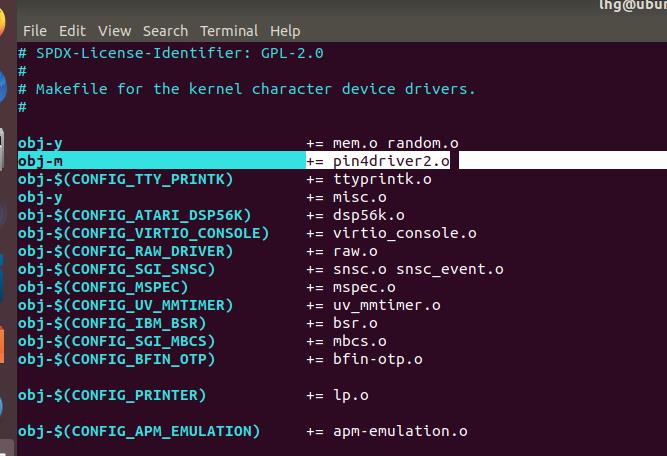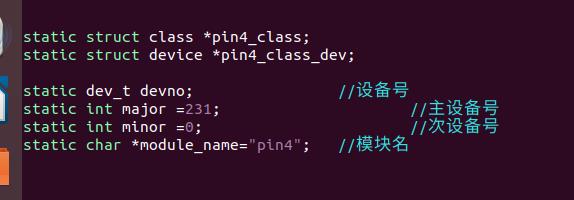高手进阶:Linux操作系统驱动编译与运行
Posted
tags:
篇首语:本文由小常识网(cha138.com)小编为大家整理,主要介绍了高手进阶:Linux操作系统驱动编译与运行相关的知识,希望对你有一定的参考价值。
参考技术A 一、手工加载测试1、insmod
./key_test.ko
加载驱动模块到内核
2、cat
/proc/modules
|grep
key_test
查看key_test模块在内核中的地址,不加过滤器可以看到全部加载的模块。
3、lsmod
显示模块,这时可以看到所有的模块名字,后面跟的是主设备号和次设备号。
4、rmmod
key_test
把模块从内核里卸载。
二、动态加载
1、把key_test.c源代码放到内核源代码的/drives/char/下,因为这是属字符型驱动,放在这编译到zImage中。
2、这时我们make
menuconfig
编译内核是看不到key_test这个选项的。我们把这个选项写到菜单里面才行。在内核源代码的/drives/char/下有一个Kconfig文件,打开
(1)
vi
Kconfig
加几行到里面:
config
ConFig_key_test
bool
"key
test"
//前面那个bool换成tristate就是支持模块化编译
上面句是在make
menuconfig时会出现key
test这个选项在drive/char子菜单下,bool前面是TAB键
------help----------
这句是出现在菜单选项下面的
This
key
test
help.
这句是你的驱动的说明会出现在help里面
(2)在/drivers/char目录下的Makefile文件里加上一句:
obj-$(CONFIG_key_test)
+=
key_test.o
上面这句是让Make时把key_test编译到内核中.
(3)
make
menuconfig
把key_test选项选取上
(4)
make
zImage
生成zImage文件,重启动加载这个新编的内核。
3、lsmod就能看到key_test了,但是还不能用,没有接口,也就是/dev下面没有
4、mknod
/dev/key_test
c
121
0
这是创建设备到/dev下,使普通程序可以调用了,121是在源代码里定义的它的主设备号,0是次设备号。
5、cat
/dev/key_test
这是相当于open这个设备了,或者写一个程序直接调用open、write等函数。
fd=("/dev/key_test",ORW);
驱动代码编译和测试
目录
一、交叉编译测试文件及驱动发送至树莓派
1、驱动编译与发送
驱动框架程序:
#include <linux/fs.h> //file_operations声明
#include <linux/module.h> //module_init module_exit声明
#include <linux/init.h> //__init __exit 宏定义声明
#include <linux/device.h> //class devise声明
#include <linux/uaccess.h> //copy_from_user 的头文件
#include <linux/types.h> //设备号 dev_t 类型声明
#include <asm/io.h> //ioremap iounmap的头文件
static struct class *pin4_class;
static struct device *pin4_class_dev;
static dev_t devno; //设备号
static int major =231; //主设备号
static int minor =0; //次设备号
static char *module_name="pin4"; //模块名
//led_open函数
static int pin4_open(struct inode *inode,struct file *file)
printk("pin4_open\\n"); //内核的打印函数和printf类似
return 0;
//led_write函数
static ssize_t pin4_write(struct file *file,const char __user *buf,size_t count, loff_t *ppos)
return 0;
static struct file_operations pin4_fops =
.owner = THIS_MODULE,
.open = pin4_open,
.write = pin4_write,
;
int __init pin4_drv_init(void)
int ret;
devno = MKDEV(major,minor); //创建设备号
ret = register_chrdev(major, module_name,&pin4_fops); //注册驱动 告诉内核,把这个驱动加入到内核驱动的链表中
pin4_class=class_create(THIS_MODULE,"myfirstdemo");
pin4_class_dev =device_create(pin4_class,NULL,devno,NULL,module_name); //创建设备文件
return 0;
void __exit pin4_drv_exit(void)
device_destroy(pin4_class,devno);
class_destroy(pin4_class);
unregister_chrdev(major, module_name); //卸载驱动
module_init(pin4_drv_init); //入口
module_exit(pin4_drv_exit);
MODULE_LICENSE("GPL v2");
进入如下路径,打开Makefile文件

Makefile文件里加入如图代码,-m为模块化方式,pin4deiver2为文件名

输入如下编译:modules模块化方式
ARCH=arm CROSS_COMPILE=arm-linux-gnueabihf- KERNEL=kernel7 make modules
可以看到生成了pin4driver2.ko

通过scp指令将该ko文件发送到树莓派上 文件路径和ip需要更改
scp drivers/char/pin4driver2.ko pi@192.168.137.6:/home/pi
2、测试文件交叉编译与发送
#include <sys/types.h>
#include <sys/stat.h>
#include <fcntl.h>
#include <unistd.h>
#include <stdio.h>
int main()
int fd;
int a='1';
fd=open("/dev/pin4",O_RDWR);
if(fd<0)
printf("open failed\\n");
perror("reason:");
else
printf("open success\\n");
fd=write(fd,&a,1);
对该.c文件进行交叉编译
arm-linux-gnueabihf-gcc pin4test.c -o pin4test
用scp指令将pin4test文件发送到树莓派上
scp pin4test pi@192.168.137.6:/home/pi
二、测试驱动
1、加载内核驱动
树莓派上输入如下命令
sudo insmod pin4driver2.ko


可以看到设备号和程序写的一致
2、更改权限
666所有用户均可读写
sudo chmod 666 /dev/pin4

3、运行测试文件调用驱动
./pin4test可以看到运行成功,dmesg可以看到内核调用函数成功

以上是关于高手进阶:Linux操作系统驱动编译与运行的主要内容,如果未能解决你的问题,请参考以下文章